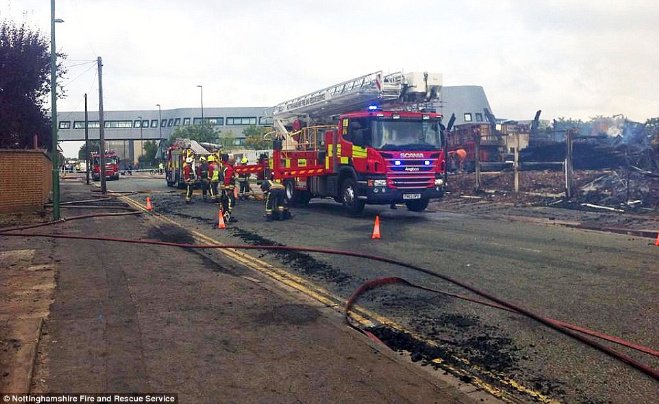
The fire that destroyed a laboratory that Morgan Sindall was building at the University of Nottingham last autumn was probably caused by an electrical fault and became devastating because of the construction methodology chosen, an official report says.
With the £20m glulam building only 70% complete, there were no fire doors, limited glazing and open voids between floors whenmt he fire took hold on 12th September 2014
The official report by Nottinghamshire’s chief fire officer John Buckley says: “Whilst services were being installed and commissioned this caused the building to be self-ventilating and once the fire had taken hold it then passed through the building rapidly and with some ferocity.”
The GlaxoSmithKline Carbon Neutral Laboratory for Sustainable Chemistry is being built on the University of Nottingham’s Jubilee campus. Main contractor Morgan Sindall has had to start over again after the September fire completely destroyed all its previous work, with nothing to salvage.
The building was a timber-framed building and wood was the predominant construction material throughout. This construction method of gluing laminated timber together – glulam – has been shown to satisfy all building and fire safety regulations when complete. However, Mr Buckley’s report points out, they are vulnerable from fire during the construction phase. “As such recent examples of fires in timber framed buildings nationally have resulted in total loss incidents,” he says.
A Morgan Sindall spokesperson said: “We acknowledge publication of the Nottinghamshire Fire & Rescue Service report into the fire at the GlaxoSmithKline building on Triumph Road, Radford, which highlights the most probable cause of the fire as being electrical.
“Morgan Sindall plc is proactively working as part of a multi-agency group, including the HSE, to identify any additional areas for industry learning which could be made.
“The rebuilding work, which has already commenced, is based on the same design principles as before and outwardly the building will be indistinguishable from the original design. Although the building design has always been fully-compliant with industry guidelines, we will be adhering to the updated guidance relating to the erection of timber framed structures which was issued by the Structural Timber Frame Association in November 2014.
“The original dedicated Morgan Sindall plc project team is delighted to be undertaking the rebuild with the same subcontractors, who are all committed to seeing the new building successfully delivered.”
The official report of the chief fire officer also gives an insight into the investigation process as well as the next steps:
Early assumptions could be made relatively quickly into the process due to the fact that the building was still under construction. At the time of the fire it was found that the building did not have a mains gas or mains electrical supply. As such ignition related to the mains supplies from the utilities could be discounted.
What is of note is that there was a temporary power supply to the building for primary lighting, emergency lighting and for transformers to power electrical tools and charge mobile working platforms. Whilst all of these items were portable appliance tested at this stage they could not be discounted as a possible source of ignition.
As a result of the evidence gathering process and the discounting of possible ignition sources, electrical as a cause became the most probable cause. Although a fault with the mains utility supply had previously been discounted, it was established that there was a temporary electrical supply into not only the site, but also into the building under construction itself.
With the support of Morgan Sindall the investigation secured plans not only of the route that the temporary cable installation took, but also the nature and type of electric construction equipment that was in each area of the building. By surveying the scene post fire, the remains of these items were identified, marked and photographed in situ.
Over the days that followed and through the cross checking of the evidence and data available, it was finally determined that the most probable cause for the fire was electrical and the origin or location of the fire was on the first floor underneath the base of horn 1.
At this stage of the construction, without fire doors or in some areas glazing, there were open voids between floors. Whilst services were being installed and commissioned this caused the building to be self-ventilating and once the fire had taken hold it then passed through the building rapidly and with some ferocity.
The final phase of the investigation is to debrief the operational crews with a view to consolidating and refining future practice. This is a standard procedure undertaken by the Service, and due to the resources committed in dealing with this incident there is the potential to interrogate and capture a rich vein of feedback.
Additionally there will be a multi-agency meeting to look at the industry standards that were adopted and applied to this build. The brief will be to determine how effective these were despite the loss and what areas if any can be improved or bolstered for the future.

